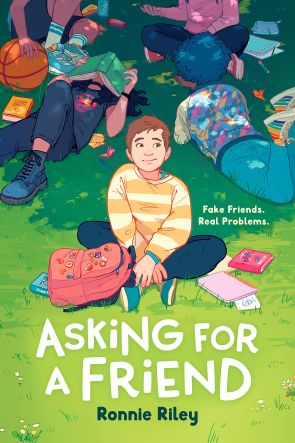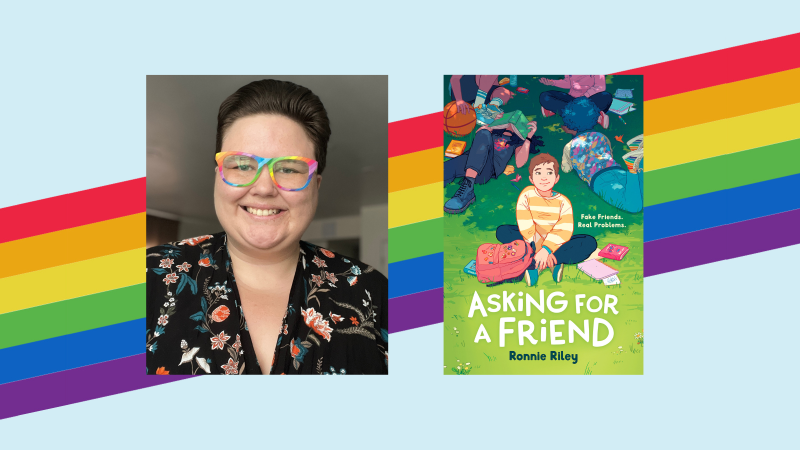This post was written by Brooks Jewell, Scholastic's Director of Internal Communications.
Ronnie Riley’s latest book, Asking for a Friend, which debuted on June 4, features Eden, a socially anxious non-binary middle school student. Eden is starting a new school, which is hard enough, but it’s even harder putting a good face on things for their mom. To cope, Eden invents a posse of “friends.” All real kids from school, but they’ve never actually spoken to any of them before. Problem solved…until their mom decides to throw at 13th birthday party – and everyone’s invited!
As part of our celebration of Pride Month, we talked with Ronnie about their latest book and how their friends (and guinea pigs) helped inspire the story.
In your author’s note at the end of the book – you pen an inspiring note for the Edens, Dukes, Tabithas, Jackies, and Ramonas out there in your reader-verse. How have your friends inspired each of these characters?
I’ve put the best parts of my best friends into each character–the trust, loyalty, the learning, the growth, the acceptance, the love–characters who sometimes miss the mark, but always keep trying. While I haven’t personally made a friend due to a food fight, I have made a best friend by meeting eyes across a room for a group project. I wanted to incorporate those types of moments into Eden’s journey of friendship.
 Asking for a Friend delves into the complexities of friendship, which are made even harder by Eden’s social anxiety. What’s the main thing you want your readers to learn from Eden’s journey?
Asking for a Friend delves into the complexities of friendship, which are made even harder by Eden’s social anxiety. What’s the main thing you want your readers to learn from Eden’s journey?
I really want readers to learn that friends are worth it–whether it’s awkward at first, smooth sailing, or a little bit of both. Conflict doesn’t have to mean the end of a friendship (whether it’s within a friend group or with things outside of your control), because as long as you’re willing to be uncomfortable and navigate some hard things, the joy and love of friendship is worth it.
Both Eden Jones and Jude (the protagonist of your first novel Jude Saves the World) are 12 years old and in middle school – why is that such an important age for you to depict?
This is an important age for me personally because there are so many changes going on at age 12: physically, emotionally, and socially. Looking back, I think age 12 was such a difficult time for me because I didn’t understand that I was nonbinary— I didn’t have that language back then, and I certainly didn’t have any queer elders in the small town I grew up in. I think I write specifically for kids who are going through big changes and trying to figure out who they are at such a tumultuous time.
If you could go back and talk to your 12-year-old self – what would you say?
I’d tell 12-year-old Ronnie that things are going to be okay. I’d sit them down and tell them all about queerness and its many facets–how their identity will change and grow as they learn more about themselves and how that’s okay. And I’d tell them that they’ll meet the love of their life who accepts them just as they are.
As a nonbinary author, how do you approach representation in your novels and what impact do you want diverse representation to have on young readers?
Part of me writes what I know — which is being nonbinary and queer, and having many different kinds of queer and trans friends. I think it’s so important for books to show young readers that even if someone is different from you in some way, there are things you can connect with and relate to, and things you can learn from one another. Diversity in stories can help us understand one another.
Could you share any interesting anecdotes or challenges you faced while writing Asking for a Friend? Did the story evolve during the drafting process?
One funny thing is that the bookseller at Uncle Moe’s— Kevin— is named after a friend of a friend’s guinea pig! He was part of a story my partner brought home from school around the same time I was writing Asking for a Friend, and I used the name, not even realizing. It wasn’t until Jules (my partner) read part of the first draft and laughed about it! So, Kevin was unintentionally inspired by a guinea pig.
The biggest evolution of the story was Ramona. Creating an arc for her that isn’t too mean but also shows how kids can make mistakes, be influenced by wrong people, and still grow into a person who deserves a second chance wasn’t something I felt I got right in the first draft. It was something I worked hard with my editors to really nail down.
You mention that you enjoy ice cream any day of the year and, among other things, collect books and cats. How many cats do you have, what are you reading right now, and what’s your favorite flavor of ice cream?
This is a wonderful question, thank you! I currently have 3 cats: Minnie, Sophie, and Tilly! I just finished reading Linus and Etta Could Use a Win by Caroline Huntoon, which was incredible, and recently also enjoyed One Killer Problem by Justine Winans Pucella. And my favorite ice cream is anything chocolate — chocolate brownie, chocolate Oreo, chocolate peanut butter — all the chocolate!



